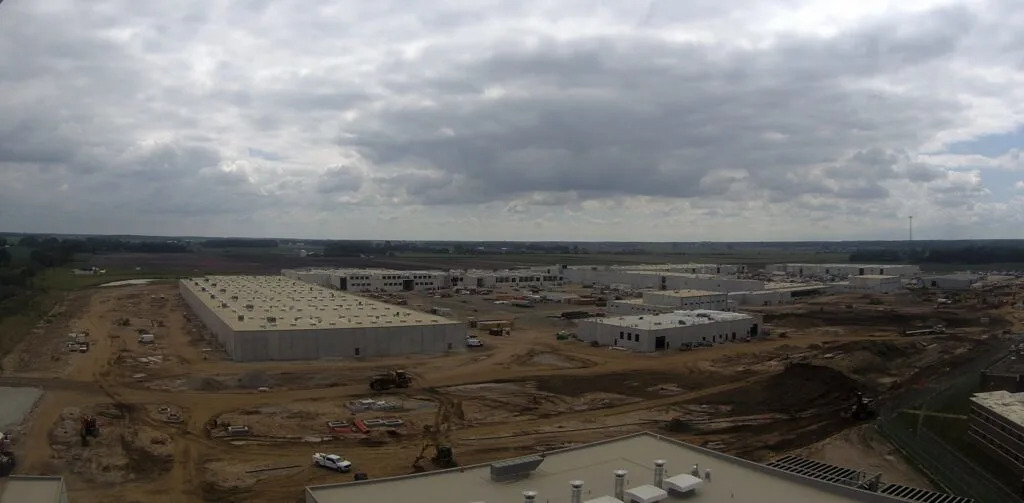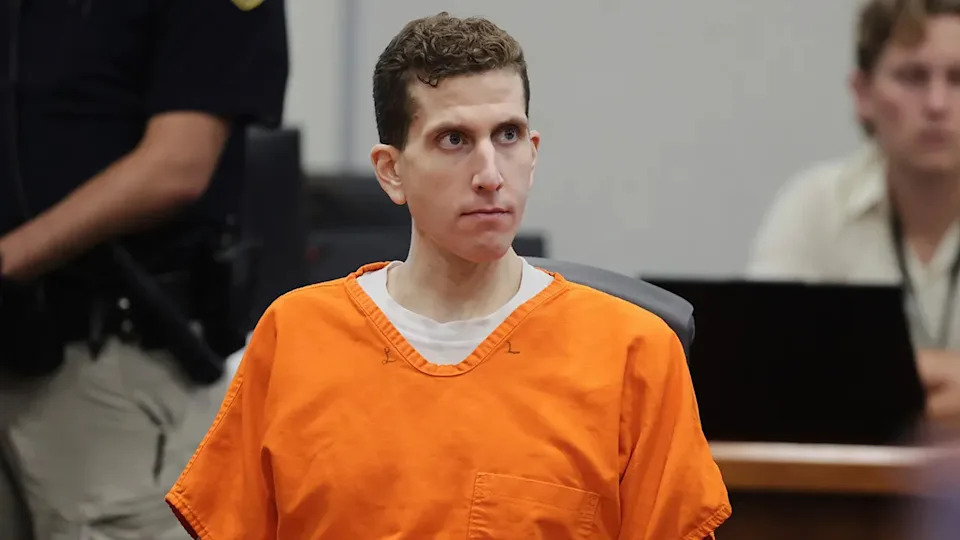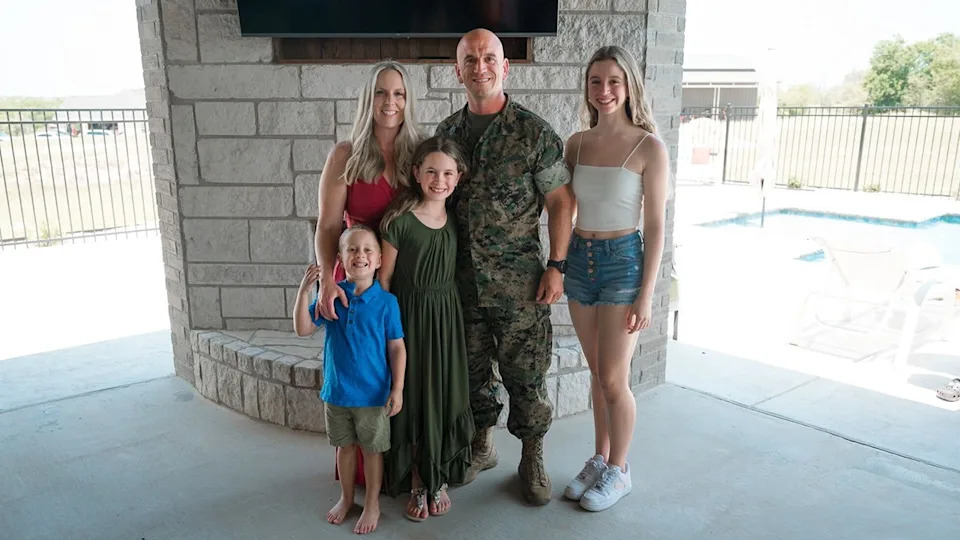
A live look at ongoing construction at the site of the new Northwest Indiana Correctional Facility in Westville, taken on Aug. 21, 2025. (Photo courtesy Indiana Department of Correction)
State corrections officials are backing away from earlier plans to close the Indiana State Prison in Michigan City once a new $1.2 billion facility opens in 2027, saying they now intend to keep the aging lockup operating for “some time” after the new prison site begins housing inmates.
That’s a change from the The Indiana Department of Correction’s earlier consolidation plan laid out in 2023, which called for shuttering both Indiana State Prison and Westville Correctional Facility to save on staffing and operating costs.
Instead, DOC confirmed to the Indiana Capital Chronicle this week that Westville will close as originally planned, but the state prison will remain open indefinitely.
The Westville facility is just 14 miles south of Michigan City, where the Indiana State Prison is located.
The new correctional facility — which DOC calls the Northwest Indiana Correctional Facility — is still under construction on the site of the current Westville correctional campus.

“DOC still intends to close Westville Correctional Facility with the opening of the new Northwest Indiana Correctional Facility,” said DOC spokesperson Annie Goeller. “We have been collaborating with state and local officials on the future of the Indiana State Prison, which we intend to keep open for some time after the opening of the new facility. At this time, we have not yet determined how long that will be.”
It’s not clear, though, whether DOC’s cooperation with federal immigration authorities influenced the timeline.
Earlier this month, Gov. Mike Braun’s administration announced it would lease up to 1,000 empty state prison beds to the federal government to house immigration detainees.
Goeller cited recent growth in the state’s incarcerated population as a factor but did not say specifically if arrangements with federal officials factored into the decision to keep the state prison open longer.
“DOC’s population has been growing for the last several months and we are focused on utilizing our current space efficiently, which includes the space at Indiana State Prison,” she said.
Even so, the Indiana Public Defender Council expressed concern that federal contracts could stretch already thin staff even further.
“Our prisons are already understaffed, with correctional officers overworked and pulled away from their core mission of humanely housing and rehabilitating the people in their charge,” the group said. “Additional federal demands only hinder the state’s ability to maintain the standards of safety and rehabilitation it has worked hard to achieve.”
The council additionally pointed to a December 2024 agreement between then-Gov. Eric Holcomb and Michigan City that envisioned transferring the site to the city by 2029.
“IPDC has always recognized that the Indiana State Prison could not be decommissioned overnight, but Governor Holcomb’s letter of intent to transfer ownership to Michigan City by January 1, 2029, suggested its closure was on the horizon,” the council said. “We hope that remains the plan.”
A new prison in the works
Construction on the new Northwest Indiana Correctional Facility is proceeding on schedule, and is under budget.
Goeller said a “majority of buildings” have their exterior completed and interior work is ongoing.
The new facility is set to open in 2027.
Elevatus Architecture was selected to lead the $1.2 billion effort, from planning through construction completion. The campus design consists of 28 buildings totaling about 1.4 million square feet. It’s the first new prison built in Indiana in more than 20 years.
According to the architecture firm, administrative spaces at the new prison site will be enhanced to provide amenities for staff “that they have not been afforded in the existing facilities.”
A medical area and dedicated mental health building for inmates are under construction, too. Recreational spaces, vocational programs and industrial manufacturing are also included in the campus design.
The maximum-security facility will have 4,200 beds, making it one of the largest in the state.
When the project was announced in 2023, DOC leaders emphasized cost savings as the driving motivation.

Then-Commissioner Christina Reagle told lawmakers the consolidation would save the state $45 million a year in operating costs, noting that it would not be “cost effective” to renovate the 163-year-old Indiana State Prison.
The state’s budget leaders backed the plan, pointing to long-term efficiency gains by staffing and maintaining one modern complex instead of two outdated ones. Initially lawmakers set aside about $400 million in 2021 but inflation and supply chain challenges caused a boost in the 2023 budget.
Both existing facilities are now running near capacity — and the state’s prison population keeps ticking upward.
DOC’s latest figures for August show that the Indiana State Prison is housing 2,436 inmates in 2,486 available beds, putting it at nearly 98% of its capacity. Westville holds 2,858 inmates in 3,013 beds, at about 95% capacity.
Both prison facilities have additional bed space — around 463 beds in Westville and 52 beds in Michigan City — but DOC officials said staffing and maintenance constraints, among other issues, have kept those beds offline.
The future of the Indiana State Prison site
The long-term fate of the sprawling Indiana State Prison property remains unclear.
Holcomb signed a letter of intent with Michigan City in December 2024, laying the groundwork to transfer ownership of the prison site to the city by Jan. 1, 2029. That agreement was meant to give Michigan City time to plan while the new prison was under construction.
The deal was described as part of an Indiana State Prison “reimagination strategy,” aimed at spurring community-driven redevelopment of the site.
Local leaders in Michigan City have spent the past year gathering ideas for how the historic prison site might be reused once the state vacates it.
Residents have suggested everything from mixed-use housing and business space to parks and cultural attractions, noting the waterfront location and historic architecture as assets.
The effort has already drawn state backing. Michigan City was awarded READI 2.0 funds to support community planning around the site, which officials say will help with public engagement and long-term design work.
If Indiana State Prison remains open beyond 2029, however, DOC and the Indiana Department of Administration may have to revisit the agreement terms.
Because Holcomb’s letter of intent was not a final deed transfer, state officials have acknowledged that DOC, IDOA and Michigan City would might need to negotiate a new arrangement if the prison facility is still operational at the end of the decade.
That could mean pushing back the transfer date, entering into a phased transfer or striking a revised agreement that allows part of the site to be repurposed while the prison continues operating elsewhere on the grounds. IDOA did not reply to the Capital Chronicle’s request for comment about the deed transfer.
The public defender council said the delayed closing decision underscores state expectations that the prison population will continue to rise.
“[I]t is no secret that DOC is preparing for a larger prison population, with projections indicating the count could exceed 28,000 by 2028,” the group continued. “While many factors play a role, a central driver is the reduction in credit time enacted in the 2014 criminal justice reforms, compounded by new crimes and sentence enhancements. In other words, policy choices, not crime rates, are fueling this growth.”
SUBSCRIBE: GET THE MORNING HEADLINES DELIVERED TO YOUR INBOX








Comments